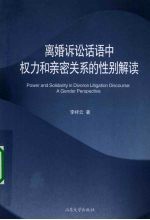
- 作 者:李祥云著
- 出 版 社:济南:山东大学出版社
- 出版年份:2009
- ISBN:9787560739113
- 标注页数:301 页
- PDF页数:323 页
请阅读订购服务说明与试读!
订购服务说明
1、本站所有的书默认都是PDF格式,该格式图书只能阅读和打印,不能再次编辑。
2、除分上下册或者多册的情况下,一般PDF页数一定要大于标注页数才建议下单购买。【本资源323 ≥301页】
图书下载及付费说明
1、所有的电子图书为PDF格式,支持电脑、手机、平板等各类电子设备阅读;可以任意拷贝文件到不同的阅读设备里进行阅读。
2、电子图书在提交订单后一般半小时内处理完成,最晚48小时内处理完成。(非工作日购买会延迟)
3、所有的电子图书都是原书直接扫描方式制作而成。
Chapter 1 Introduction 1
1.1 Rationales for the present research 1
1.1.1 Theoretical rationale 1
1.1.2 Practical rationale 4
1.2 Research questions 5
1.3 Methodology of the present research 6
1.3.1 Data collection 6
1.3.2 Transcription of the data 8
1.3.3 Calculation and interpretation of the results 9
1.4 Organization of the book 9
Chapter 2 Literature Review:Two Main Social Approaches 11
2.1 Introduction 11
2.2 Related law issues in China 11
2.2.1 Inquisitorial system 11
2.2.2 Trial procedures 13
2.2.3 Mediation 14
2.3 Forensic linguistics 20
2.3.1 Forensic linguistics abroad 21
2.3.2 Forensic linguistics in China 24
2.4 Power and forensic linguistics 25
2.4.1 Power:A social perspective 25
2.4.2 Power:A linguistic perspective 29
2.4.3 Power in forensic linguistics 36
2.5 Gender and language 46
2.5.1 Sex and gender 46
2.5.2 Men and women in society 47
2.5.3 Linguistic studies on gender 53
2.6 Summary 61
Chapter 3 Relevant Linguistic Theories and the Analytical Framework 63
3.1 Introduction 63
3.2 Critical discourse analysis 64
3.2.1 Feminist critical discourse analysis 66
3.2.2 Fairclough's three-level model 69
3.3 Systemic functional linguistics 72
3.3.1 Language as a social semiotic system:Key tenets of SFL 73
3.3.2 Systemic functional linguistics in critical discourse analysis 79
3.4 Appraisal theory 81
3.5 Conversation analysis 87
3.6 The analytical framework 90
3.7 Summary 94
Chapter 4 Power and Solidarity in Court:The Lexicogrammatical Level 96
4.1 Introduction 96
4.2 Power and solidarity 97
4.2.1 Power and solidarity in court 101
4.2.2 Power in marriage 105
4.2.3 Power comparisons in twelve cases 110
4.3 Appraisal elements in court discourse 123
4.3.1 Affect 124
4.3.2 Engagement and deontic modality 143
4.3.3 Graduation 157
4.4 Summary 168
Chapter 5 Power and Solidarity in Court:The Textual Level 172
5.1 Introduction 172
5.2 Speech turns 173
5.2.1 Men and women's total turns in court 177
5.2.2 Turn-taking without the judge's permission 180
5.2.3 Dispreferred turns 189
5.3 Interruptions 197
5.3.1 Interruptions in court 200
5.3.2 Interpretation 218
5.4 Overlap 219
5.5 Topic initiation/change 222
5.6 Utterances inviting judges' involvement 227
5.7 Summary 233
Chapter 6 Reflected Prejudicing Ideologies in Court 240
6.1 Introduction 240
6.2 Ideology 241
6.3 Women's self-depictions 242
6.4 The judge's bias 249
6.5 Summary 253
Chapter 7 Conclusion 254
7.1 Major findings and suggestions 254
7.2 Major contributions 261
7.3 Limitations and further studies 263
Appendices 266
References 278
